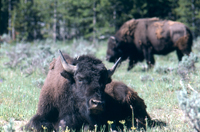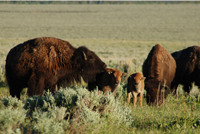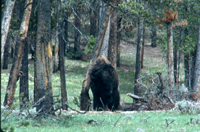It is not uncommon for visitors to the John D. Rockefeller, Jr. Memorial Parkway to step outside of their tent or cabin and see another visitor to the area. Only, this visitor has four legs rather than two and horns in addition to shaggy brown/black hair.

NPS Photo/Cooper
Who is this visitor? Well, it's not a buffalo; true buffalo only live in Asia and Africa. Your two-thousand pound neighbor is known as the American bison, or to scientists Bison bison.
The bison is the largest land mammal in North America. Bulls are more massive in appearance than cows, and more bearded. For their size, bison are agile and quick, capable of speeds in excess of 30 mph. Each year, bison injure park visitors who approach too closely.
Bison are animals of the grasslands; they eat primarily grasses and sedges. Their massive hump supports strong muscles that allow the bison to use its head as a snowplow in winter, swinging side to side to sweep aside the snow.
Cows, calves, and some younger bulls comprise a herd. Mature bulls, however, spend most of the year alone or with other bulls. The exception is during the rut, or mating season. At this time, in late July and August, bulls seek out females. They display their dominance by bellowing, wallowing, and engaging in fights with other bulls. Once a bull has found a female who is close to estrus, he will stay by her side until she is ready to mate. Then he moves on to another female.

NPS Photo/D. Lehle
After a gestation period of 9 to 9 1⁄2 months, single reddish-brown calves are born in late April and May. Calves can keep up with the herds about 2-3 hours after birth and they are well protected by their mothers and other members of the herd. However, wolves and grizzly bears have killed bison calves.
Wolves and grizzly bears are the only large predators of adult bison. Scientists have also recently seen grizzly bears hunting bison successfully. Dead bison provide an important source of food for scavengers and other carnivores.
Many insects feed upon the bison, and bison will rub against trees, rocks, or in dirt wallows in an attempt to get rid of insect pests. Birds such as the magpie "ride" a bison to feed on insects in its coat. The cowbird will also follow close behind a bison, feeding on insects disturbed by its steps.

NPS Photo/Gilmore
History
From 30 to 60 million bison may have roamed North America before the mid 1800s. Their historic range spread from the Pacific to the Appalachians, but their main habitat was the Great Plains where Plains tribes developed a culture that depended on bison. Almost all parts of the bison provided something for the Native American way of life-food, tools, shelter, or clothing; even the dung was burned for fuel. Hunting bison required skill and cooperation to herd and capture the animals. After tribes acquired horses in the 1600s, they could travel farther to find bison and hunt the animals more easily.
European American settlers moving west during the 1800s changed the balance. Market hunting, sport hunting, and a U.S. Army campaign in the late 1800s nearly eliminated bison. Yellowstone was the only place in the contiguous 48 states where wild, free-ranging bison persisted. The U.S. Army, which administered Yellowstone at that time, protected these few dozen bison from poaching as best they could. The protection and recovery of bison in Yellowstone is one of the great triumphs of American conservation.
Despite protection, Yellowstone's bison were reduced by poaching to less than two dozen animals in 1902. Fearing the demise of the wild herd, the U.S. Army brought 21 bison from ranches to Yellowstone. In 1906-07, the Buffalo Ranch in Lamar Valley was constructed to manage these bison and increase their numbers. This herd grew to more than 1,000 animals; the park's small native bison herd in Pelican Valley also slowly increased. In the 1930s, the introduced bison were allowed to move freely and intermingle with the native bison. Today, almost between 2000-4000 bison live in Yellowstone National Park, and almost 1000 bison reside in Grand Teton National Park.
-DL
Source: Yellowstone National Park. 2012. Yellowstone Resources and Issues Handbook: 2012. Yellowstone National Park, WY.
